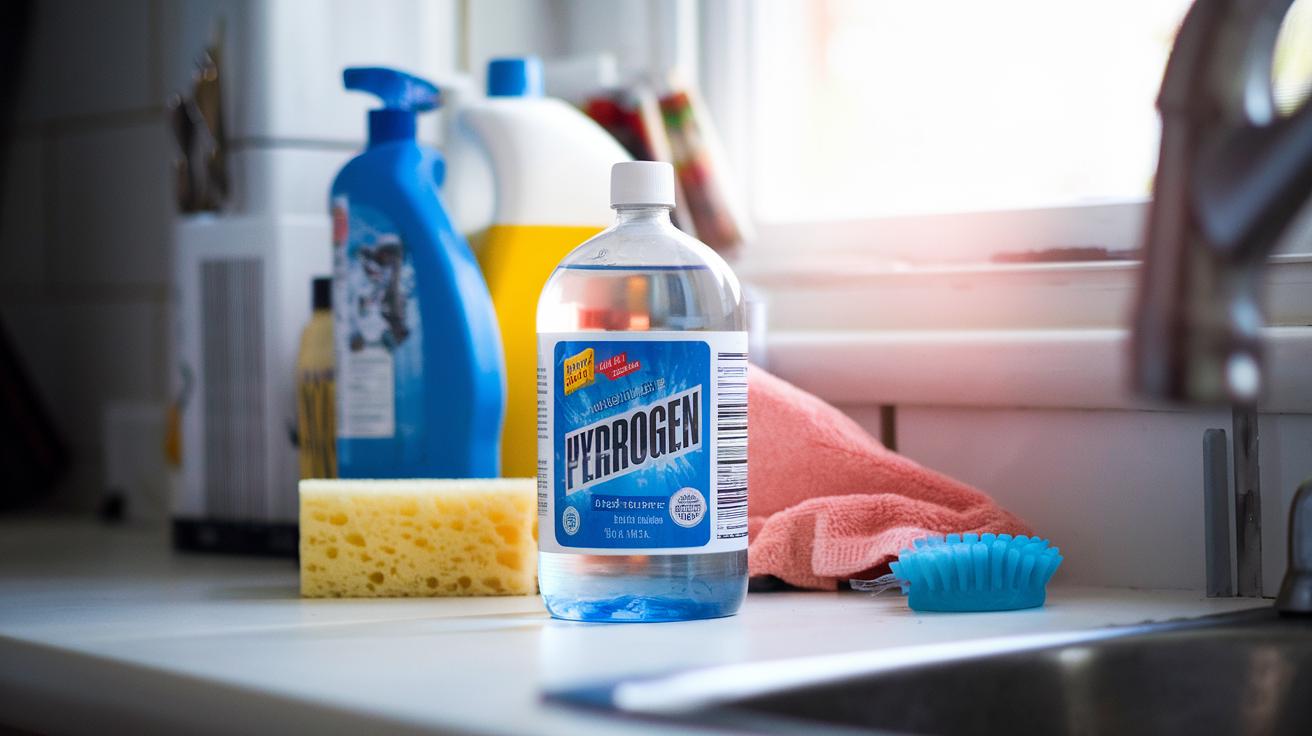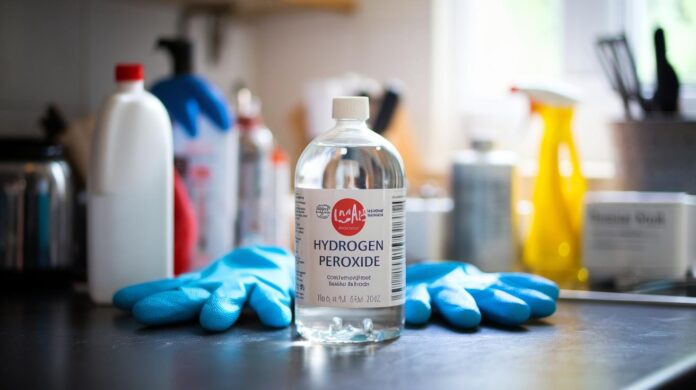Is hydrogen peroxide a hidden powerhouse in your cleaning arsenal, or is it a misunderstood menace? This versatile compound, often relegated to the medicine cabinet for first aid, offers a spectrum of household applications that can revolutionize home maintenance. From disinfecting surfaces to lifting stubborn stains, hydrogen peroxide presents an eco-friendly alternative to traditional cleaning products. This article delves into its diverse uses, providing insights into safe, efficient applications within your home. Whether you're sanitizing kitchen countertops or refreshing bathroom fixtures, learn how to harness the safe potential of hydrogen peroxide in everyday tasks.
Everyday Household Uses of Hydrogen Peroxide
Hydrogen peroxide is a versatile agent commonly found in households, offering a range of cleaning and disinfecting applications. Its chemical composition allows it to serve as both an oxidizer and a bleaching agent, making it effective for various tasks. When used in a diluted concentration, such as a 3% solution, hydrogen peroxide can clean surfaces without leaving harmful residues. It is often employed in kitchens and bathrooms, where cleanliness and hygiene are paramount. The substance's ability to break down into water and oxygen not only renders it environmentally friendly but also safe for most household uses. Its antimicrobial properties make it valuable for reducing bacteria and viruses on contact surfaces, ensuring a healthier living environment.
- Cleaning countertops
- Disinfecting bathroom fixtures
- Lifting fabric stains
- Refreshing tiled surfaces
- Sanitizing cutting boards
The bubbling action of hydrogen peroxide is particularly advantageous for lifting stains from various materials like fabrics, carpets, and upholstery. This effervescence helps to loosen and remove embedded dirt and grime without the need for abrasive chemicals, safeguarding the integrity of the items being cleaned. Beyond its stain-lifting capabilities, hydrogen peroxide is a powerful disinfectant, capable of neutralizing a wide spectrum of pathogens. By mixing it with water, users can create an effective sanitizing solution suitable for multiple surfaces. This versatility makes hydrogen peroxide a staple in household cleaning regimens, offering an efficient and economical means of maintaining cleanliness and hygiene.
Cleaning and Disinfecting with Hydrogen Peroxide

Hydrogen peroxide serves as a natural disinfectant, renowned for its capability to eliminate bacteria, viruses, and mold on various surfaces. Its effervescent properties not only aid in breaking down grime but also make it an environmentally friendly option for household cleaning tasks. Utilizing a 3% solution, hydrogen peroxide can be safely applied to numerous areas, ensuring a hygienic environment without the use of harsh chemicals.
Disinfecting Countertops
To disinfect countertops effectively, mix equal parts of hydrogen peroxide and water in a spray bottle. Spray the solution directly onto the countertop surface, allowing it to sit for at least five minutes. This contact time enhances the antimicrobial action, ensuring thorough disinfection. Afterward, wipe the surface with a clean cloth to remove any residue. This approach not only sanitizes the counters but also helps maintain their appearance without leaving behind harmful residues.
Bathroom Cleaning
For cleaning bathroom fixtures, hydrogen peroxide can be used as a toilet cleaner and grout whitener. To clean toilets, pour a cup of hydrogen peroxide into the bowl and let it sit for approximately 15 minutes before scrubbing with a toilet brush. This method effectively removes stains and disinfects the bowl. For grout whitening, create a paste with hydrogen peroxide and baking soda. Apply the paste to the grout lines, let it sit for a few minutes, and scrub with a toothbrush before rinsing. The bubbling action helps lift dirt and brighten the grout without damaging the tiles.
Mold Removal
Hydrogen peroxide is effective in mold removal when applied as a 3% solution. Spray the solution directly onto moldy areas, allowing it to sit for at least 10 minutes to penetrate and kill mold spores. After the waiting period, scrub the area with a brush to remove any remaining mold. Finally, rinse the surface with water and dry thoroughly to prevent mold recurrence. Always ensure proper ventilation and wear protective gear during this process to minimize exposure to mold and cleaning agents.
Using Hydrogen Peroxide for Laundry
Hydrogen peroxide is a multifaceted laundry aid, offering a greener, more sustainable alternative to traditional bleach. It functions not only as a whitening agent but also excels in deodorizing, brightening, and disinfecting fabrics. Its composition allows it to break down into harmless water and oxygen, minimizing environmental impact while achieving superior cleaning results. Particularly effective on dye-stable fabrics, hydrogen peroxide can be added directly to the washing machine, enhancing the overall hygiene of the laundry process. This versatility ensures that clothes maintain their vibrancy and freshness without the risk of damage associated with harsher chemical bleaches.
For stain removal, hydrogen peroxide is unmatched in its efficacy. Its bubbling action targets and lifts stains, making it suitable for both pre-treatment and in-wash applications. When addressing stubborn stains, apply a small amount of hydrogen peroxide directly to the affected area and let it sit for a few minutes before washing. This method is particularly effective for organic stains such as blood, wine, and grass. Its gentle yet potent cleaning ability ensures that fabrics are not only free of blemishes but also protected from the weakening effects often caused by conventional stain removers.
|Laundry Use|Benefit|
|—|—|
|Whitening|Brightens whites without chlorine|
|Stain Removal|Targets and lifts tough stains|
|Deodorizing|Neutralizes unpleasant odors|
|Disinfecting|Eliminates bacteria and germs|
Personal Care and Hygiene Applications

Hydrogen peroxide plays a significant role in oral hygiene due to its ability to whiten teeth and eliminate bacteria. Using a 3% solution as a mouth rinse can help reduce oral bacteria, freshen breath, and whiten discolored teeth. Swishing a diluted solution for about 30 seconds before spitting out can be effective. It's critical to avoid swallowing the solution to prevent any adverse effects.
In wound cleaning, hydrogen peroxide is commonly used to disinfect cuts and abrasions. Applying a 3% solution helps remove debris and bacteria, though it's essential to be cautious as it may damage healthy tissue and delay healing. For skin care, hydrogen peroxide can be used to lighten discolored nails and even hair. When applied carefully, it serves as a gentle bleaching agent, though it's important to limit its use to prevent skin irritation.
Beyond these uses, hydrogen peroxide is beneficial in maintaining beauty tools and personal items. Disinfecting toothbrushes with a 3% solution can kill germs and bacteria on the bristles. Similarly, beauty tools can be sanitized by wiping them with hydrogen peroxide, ensuring cleanliness and reducing the risk of skin infections. This practice not only extends the life of these tools but also supports overall hygiene.
Safe Usage and Precautions with Hydrogen Peroxide
When using hydrogen peroxide at home, it is critical to consider safety to prevent harm to skin and surfaces. Hydrogen peroxide can damage healthy skin cells if applied undiluted or used excessively. A 3% solution is generally safe for household applications, such as cleaning and disinfecting, but it should never be mixed with vinegar. This combination produces peracetic acid, a corrosive substance that can irritate skin, eyes, and respiratory organs. Therefore, understanding and adhering to recommended concentrations is essential to safeguard health and ensure the effective use of hydrogen peroxide.
- Avoid mixing with vinegar
- Use appropriate concentrations
- Store away from children
- Wear gloves for prolonged use
Safe storage and handling are also vital when using hydrogen peroxide. The solution should be kept in a cool, dark place and stored out of reach of children to prevent accidental ingestion or exposure. Wearing gloves during prolonged use can protect hands from irritation, especially when cleaning or disinfecting large areas. By following these precautions, hydrogen peroxide can be used effectively and safely in various household applications.
Final Words
Exploring how to use hydrogen peroxide at home reveals its multifaceted role as a reliable cleaning agent, effective disinfectant, and eco-friendly laundry aid. While its bubbling action lifts stains and refreshes surfaces, it also offers practical applications in personal care and hygiene. Ensuring safe use around the household maximizes its benefits while minimizing potential hazards. Armed with these insights, individuals can confidently incorporate hydrogen peroxide into their daily routines, fostering a cleaner, healthier home environment. Embracing its versatility can enhance both household maintenance and personal care practices.
FAQ
What are 50 uses for hydrogen peroxide?
Hydrogen peroxide is versatile, used for cleaning, disinfecting surfaces, laundry aids, oral hygiene, and wound cleaning. It lifts fabric stains, disinfects countertops, cleans tiles, whitens teeth, and sanitizes beauty tools.
How to use hydrogen peroxide at home for cleaning?
Mix hydrogen peroxide with water for cleaning countertops, disinfecting bathroom fixtures, and sanitizing cutting boards. Its bubbling action lifts stains from fabrics, carpets, and upholstery effectively.
How to use hydrogen peroxide at home for wounds?
Hydrogen peroxide can clean wounds using a 3% solution, but caution is advised to avoid harming healthy cells. Use sparingly and consult healthcare guidance for wound management.
Where to buy hydrogen peroxide for cleaning?
Hydrogen peroxide is widely available at pharmacies, grocery stores, and online retailers. It typically comes in 3% concentration, suitable for household cleaning and disinfecting tasks.
What is the best way to use hydrogen peroxide?
The best use involves a 3% concentration for cleaning and disinfecting surfaces, whitening laundry, and oral hygiene. It's cost-effective, eco-friendly, and safer than chemical-based alternatives for various applications.
What should you not clean with hydrogen peroxide?
Avoid using hydrogen peroxide on colored textiles that aren’t dye-stable, and don’t mix it with vinegar, as this combination produces peracetic acid, which is corrosive and unsafe for household use.
Can you apply hydrogen peroxide directly to the skin?
Direct application of hydrogen peroxide to the skin is feasible but should be restricted to a 3% solution. Avoid prolonged use to prevent irritation and damage to healthy skin cells.
What can you use hydrogen peroxide for in the house?
At home, use hydrogen peroxide for disinfecting surfaces, cleaning tiles, stain removal in fabrics, sanitizing kitchen tools, and for personal care, including teeth whitenin


